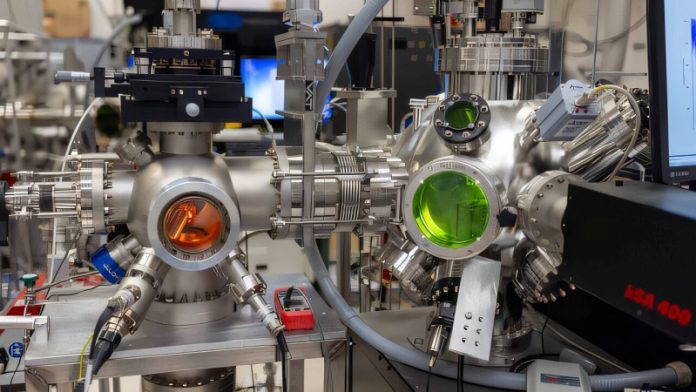
In a major breakthrough, scientists have successfully combined two unusual materials—once thought impossible to merge—into a brand-new artificial structure that could open doors to future quantum technologies.
The discovery, led by researchers at Rutgers University–New Brunswick, could help create more powerful quantum computers and advanced sensors.
The study, featured on the cover of Nano Letters journal, describes how the research team spent four years building a tiny layered structure—like a sandwich—made from two rare, lab-created materials.
Each material is already fascinating on its own, but combining them creates a whole new system that researchers had never seen before.
One layer of the sandwich is made of dysprosium titanate, a compound known as “spin ice.”
This material is used in nuclear reactors and has a strange magnetic structure where tiny magnets—called spins—are arranged just like the water molecules in ice.
These spins can form unusual particles called magnetic monopoles. Normally, magnets always have a north and south pole, but a magnetic monopole behaves like a magnet with only one pole.
Such particles don’t naturally exist in the universe but appear inside spin ice because of special quantum interactions.
The other layer is made of a material called pyrochlore iridate, a rare magnetic semimetal. It contains particles called Weyl fermions, which were first predicted in 1929 and only discovered in 2015.
These particles behave like light, moving quickly and spinning either left-handed or right-handed.
Because of their special properties, pyrochlore iridate conducts electricity extremely well and reacts in unusual ways to magnetic and electromagnetic fields. It is being studied for its potential use in advanced electronics.
Bringing these two unusual materials together was a huge challenge. The research team had to design and build a brand-new tool just for this purpose. The machine, called Q-DiP (short for Quantum Phenomena Discovery Platform), was completed in 2023.
It uses lasers to heat materials and place them down layer by layer at the atomic level. This special equipment allowed scientists to build the quantum sandwich and explore how these materials interact at extremely cold temperatures—close to absolute zero.
Professor Jak Chakhalian, the lead scientist on the project, said the key to the discovery was not only the idea but also the skill and dedication of the research team, including doctoral students and undergraduate students at Rutgers.
The tool they created is the only one of its kind in the United States and marks a big step forward in making new quantum materials.
Chakhalian explained that this new structure could lead to exciting new developments in quantum computing and quantum sensing.
These technologies use the strange rules of quantum physics—where particles can exist in multiple states at once—to perform calculations that would take regular computers much longer to complete.
Quantum computers have the potential to transform everything from medical research and drug discovery to finance, logistics, and artificial intelligence.
By combining the exotic magnetic and electronic features of dysprosium titanate and pyrochlore iridate, the new material can create extremely stable quantum states. These are essential for building devices like quantum sensors and spintronic devices, which use the spin of particles to process information.
This innovative research proves that by thinking creatively and developing new tools, scientists can create materials once believed to be impossible. And with that, they may be bringing us closer to the future of quantum technology.



